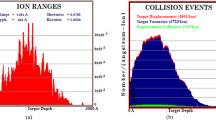Abstract
Titanium di- and sesquioxide films were epitaxially grown on the (001) surface of sapphire single-crystalline substrates by an activated reactive evaporation method. Formation range for each titanium oxide was determined as a function of oxygen pressure (Po2) by means of x-ray diffraction, transmission electron microscopy, and Raman spectroscopy. Films prepared at Po2 ≥ 2.0 × 10−4 Torr were stoichiometric (100)-oriented rutile of TiO2, and with decreasing Po2 they would accommodate more and more Ti3+ ions in the rutile structure. At Po2 = 0.6 × 10−4 Torr, on the other hand, (001)-oriented Ti2O3 was formed and an electrical transition was clearly detected at about 400 K. However, the large lattice mismatch between the substrate and these films leads to a periodic introduction of misfit dislocations in the case of the TiO2 films and a mixing of stacking sequences for the Ti2O3 films.
Similar content being viewed by others
References
K. S. Goto, Solid State Electrochemistry and Its Applications to Sensors and Electronic Devices (Elsevier, New York, 1988), p. 1.
E.G. Bauer, B.W. Dodson, D.J. Ehrlich, L.C. Feldman, C.P. Flynn, M.W. Geis, J.P. Harbison, R.J. Matyi, P.S. Peercy, P. M. Petroff, J. M. Phillips, G. B. Stringfellow, and A. Zangwill, J. Mater. Res. 5, 852 (1990).
D. C. Cronemeyer, Phys. Rev. 113, 1222 (1959).
W. W. Xu, R. Kershaw, K. Dwight, and A. Wold, Mater. Res. Bull. XXV, 1385 (1990).
Y. Gao, K. L. Merkle, H. L. M. Chang, T. J. Zhang, and D. J. Lam, Philos. Mag. A 65, 1103 (1992).
D. Wicaksana, A. Kobayashi, and A. Kinbara, J. Vac. Sci. Technol. A 10, 1479 (1992).
J. M. Honig and T. B. Reed, Phys. Rev. 174, 1020 (1968).
R. J. Nemanich, C. C. Tsai, and G. A. N. Connell, Phys. Rev. Lett. 44, 273 (1980).
P. G. Wahlbeck and P.W. Gilles, J. Am. Ceram. Soc. 49, 181 (1966).
T. Terashima, K. Iijima, K. Yamamoto, J. Takada, K. Hirata, H. Mazaki, and Y. Bando, J. Cryst. Growth 95, 617 (1989).
K. Iijima, T. Terashima, K. Yamamoto, H. Hirata, and Y. Bando, Appl. Phys. Lett. 56, 527 (1989).
J. A. Duffy, Bonding, Energy Levels and Bands in Inorganic Solids (Longman, London, 1990), p. 45.
S.P.S. Porto, P.A. Fleury, and T.C. Damen, Phys. Rev. 154, 522 (1967).
S. H. Shin, R. L. Aggarwal, B. Lax, and J. M. Honig, Phys. Rev. B 9, 583 (1974).
A. F. Wells, Structural Inorganic Chemistry, 5th ed. (Oxford, New York, 1984), p. 141.
N. F. Mott, Metal-Insulator Transitions, 2nd ed. (Taylor & Francis, London, 1990), p. 171.
Author information
Authors and Affiliations
Rights and permissions
About this article
Cite this article
Fujii, T., Sakata, N., Takada, J. et al. Characteristics of titanium oxide films deposited by an activated reactive evaporation method. Journal of Materials Research 9, 1468–1473 (1994). https://doi.org/10.1557/JMR.1994.1468
Received:
Accepted:
Published:
Issue Date:
DOI: https://doi.org/10.1557/JMR.1994.1468




